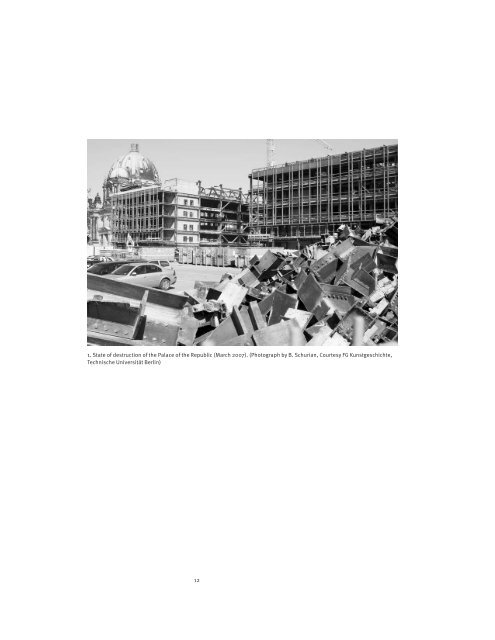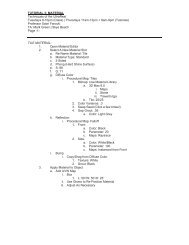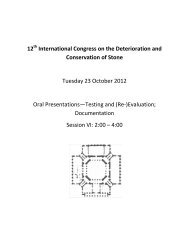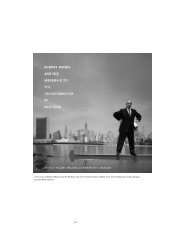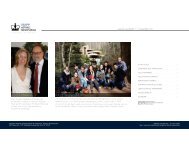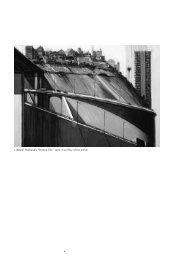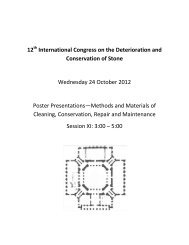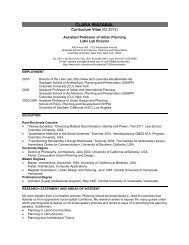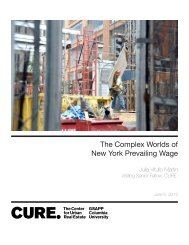Berlin's Castle Versus Palace - Columbia University Graduate ...
Berlin's Castle Versus Palace - Columbia University Graduate ...
Berlin's Castle Versus Palace - Columbia University Graduate ...
You also want an ePaper? Increase the reach of your titles
YUMPU automatically turns print PDFs into web optimized ePapers that Google loves.
1. State of destruction of the <strong>Palace</strong> of the Republic (March 2007). (Photograph by B. Schurian, Courtesy FG Kunstgeschichte,<br />
Technische Universität Berlin)<br />
12
Adrian von Buttlar Berlin’s <strong>Castle</strong> <strong>Versus</strong> <strong>Palace</strong>:<br />
Future Anterior<br />
Volume IV, Number 1<br />
Summer 2007<br />
A Proper Past for Germany’s Future?<br />
January 31, 2006: Berlin’s most influential boulevard paper BZ<br />
reported with a grin: “The <strong>Palace</strong> of the Republic [Palast der<br />
Republik] makes off…Erich’s lamp shop ends on the garbage<br />
dump of history… Destruction started exactly at eight o’clock.<br />
Nobody is shedding a tear.” That triumphant assertion was, of<br />
course, a lie in all respects.<br />
The public debate over whether to demolish or to preserve<br />
this iconic building at the very center of the capital of<br />
a freshly united Germany began in the first days of reunification<br />
in 1990, and has since carried on with strong passion on<br />
both sides. 1 Officially, the <strong>Palace</strong> battle began with arguments<br />
over health, when the building was closed due to asbestos<br />
contamination on September 19, 1990, that is, just six weeks<br />
before the official takeover by the West German Government.<br />
Like Snow White, the <strong>Palace</strong> fell asleep for seven years and<br />
was silently robbed of its political emblems, furnishings and<br />
artistic outfit. In 1997, it became clear that decontamination<br />
would mean stripping the building down to its skeleton. Thus,<br />
by the time the cleanup was finished in 2002, the <strong>Palace</strong> had<br />
already become a mysterious steel-and-glass ruin that could<br />
never regain its original character.<br />
The debate over the long-term destiny of the <strong>Palace</strong> arose<br />
from arguments over an allegedly outdated model of urban<br />
design and functionalist style typical of the now un-beloved<br />
post-World War II Modernism. Modernist buildings and public<br />
spaces, which on both sides of the Iron Curtain had once<br />
been propagated as promises of aesthetic truth, social happiness,<br />
and progress toward a new and better future, in the<br />
Post-Modern age were now defined as wounds in what is now<br />
called “the urban organism.” Modernism was a blight, which<br />
supposedly could be healed only by returning to so-called historic<br />
scale, space, texture, shape and form of the nineteenthcentury<br />
European city. On behalf of beauty, official authorities<br />
argued, reconstruction of Berlin’s former Royal <strong>Castle</strong> should<br />
replace the newfound ugliness of the socialist <strong>Palace</strong>. 2<br />
In the past half-decade, the stripped <strong>Palace</strong> was occasionally<br />
opened for cultural events such as experimental exhibitions,<br />
theater productions and concerts. It has become a nonplace:<br />
a symbol of the desire to transform conflicting histories<br />
and memories into completely new experiences and identities.<br />
In this new context, the space attained a cultural rather<br />
13
than a political presence: a role best expressed in 2005 by the<br />
monumental inscription “Zweifel”—which means “doubts”—<br />
an ingenious artistic installation by the Finn Lars Ramberg. 3<br />
Doubts, of course, in the mental uncertainty and economic<br />
depression of modern Germany, are a subversive and officially<br />
unwelcome state of mind.<br />
Every day Germans are told by our leading politicians<br />
to “look forward”—which essentially means backwards. It<br />
seems, then, that we need a proper past for our future. But<br />
which past? To answer that question, and understand whose<br />
history, memories and ideals the <strong>Palace</strong> represented and what<br />
identity might be offered in its replacement in the form of the<br />
reconstruction of Berlin’s Royal <strong>Castle</strong>, we must first ask what,<br />
or even who, the original <strong>Palace</strong> and <strong>Castle</strong> were.<br />
<strong>Palace</strong> of the Republic<br />
It is not easy to escape a neat cleavage in reigning interpretations<br />
of the <strong>Palace</strong>: on one hand, it is a nostalgic glorification<br />
of the failed German Democratic Republic (GDR); on the other,<br />
it embodies an ill-humored judgment against the socialist<br />
state, its ideology, and social collectivism. For instance, the<br />
<strong>Palace</strong>’s nickname, “Erichs Lampenladen”—the lamp shop of<br />
party leader Erich Honecker—when used by an East German<br />
before 1989 would have meant a benevolent criticism of the<br />
ostentatious splendour of the <strong>Palace</strong>’s thousands of bulbs, as<br />
the rest of the energy-short country lingered in the dark. After<br />
1989, the nickname, used in many West German newspaper<br />
articles against the <strong>Palace</strong>’s preservation, simply ridicules the<br />
whole building, its function, and its meaning.<br />
The <strong>Palace</strong> was constructed from 1973 to 1976, and ranks<br />
among the greatest of Modern multifunctional buildings of<br />
the twentieth century. Larger than the comparable Centre<br />
Pompidou in Paris, what made the <strong>Palace</strong> unique was its<br />
unusual mixture of functions spread over five floors. The most<br />
important areas were two auditoria distributed to the right<br />
and left of the <strong>Palace</strong>’s nucleus. The larger one, which accommodated<br />
5,000 people, was designed as a conference hall,<br />
and was equipped with writing desks and interpreter cabins.<br />
Socialist Party (SED) assemblies occasionally took place here,<br />
but more typically it was used for cultural or scientific events.<br />
When some of the balconies were hydraulically lowered, it<br />
could be used as a concert hall or theater, with a monumental,<br />
flexible stage. Flexibility even allowed the lowering of the<br />
whole ceiling about five meters, to dismantle the seats, and<br />
transform the auditorium into a ballroom, dinner, or reception hall.<br />
The smaller auditorium was intended for the<br />
Volkskammer, the parliament of the Republic. It has been<br />
argued that its political role was insignificant, since there were<br />
14
2. <strong>Palace</strong> of the Republic during the<br />
Tenth Party Congress of the SED (1981).<br />
(Courtesy Bundesbauamt/Archiv PdR -<br />
Fotothek FG Kunstgeschte Technische<br />
Universität Berlin)<br />
no free elections. Nevertheless, the idea of incorporating representation<br />
of the people into a public multifunctional building<br />
containing theaters, restaurants, galleries, conferences,<br />
and theatrical entertainments still seems remarkable, and<br />
recalls the modernist projects of the 1920s and 1930s, rooted<br />
in the socialist tradition. 4 Comparing the intimate neighborhood<br />
of governmental and civil public functions with worldwide<br />
security measures today, this concept demonstrates a<br />
naive optimism of the GDR elite in the era of the <strong>Palace</strong>’s construction.<br />
The hall of the Volkskammer gained special historical<br />
importance when the first freely elected Parliament of the GDR<br />
voted to join the Federal Republic on August 23, 1990. The hall<br />
is bound for protection, although not on site: only its sober<br />
interior furnishings, presently stored elsewhere, will be saved,<br />
maybe for future reconstruction in a history museum, or in the<br />
reconstructed castle—or maybe for sale on eBay. 5<br />
The wide entrance hall of the <strong>Palace</strong> opened to stairs,<br />
which led to the basement for cloakrooms, or up to the glamorous<br />
main lounges and galleries. Each day, thousands of<br />
people gathered for meetings or private appointments, or met<br />
at the monumental glass flower sculpture. Many went to one<br />
of the restaurants, the milk bar, the wine or beer tavern, all of<br />
which promised unusual luxury and variety. 6 Or they visited<br />
the galleries, created to exhibit the monumental paintings of<br />
favoured GDR artists, some of whom, like Mattheuer, Heisig,<br />
Tübke, Sitte, or Metzkes are highly estimated in art history.<br />
The <strong>Palace</strong>, conceived as a wide, shining cube, was<br />
entered from the Marx-Engels-Platz, which since the 1950s<br />
was the main setting for official GDR political demonstrations<br />
and parades. The skyline of the townscape, including<br />
Henselmann’s elegant 1969 TV Tower at Alexanderplatz, could<br />
be enjoyed from all six stories through the golden anodized<br />
glass curtain. As in West German architecture, glass facades<br />
15
3. Interior of the Grand Hall of the<br />
<strong>Palace</strong> of the Republic during the Ninth<br />
Party Congress of the SED (1976).<br />
(Courtesy Fotothek FG Kunstgeschichte,<br />
Technische Universität Berlin)<br />
signaled transparency, and transparency in the 1960s symbolized<br />
democracy. 7,8 Although aesthetically isolated from the<br />
surviving historic buildings like the Baroque Armory (1700),<br />
Schinkel’s Old Museum (1830), Ihne’s Royal Stud (1901)<br />
and Raschdorff’s Neo-Baroque Cathedral (1905), the <strong>Palace</strong><br />
considered their dimensions and possessed a remarkable<br />
aesthetical and technical elegance, reminiscent, for instance,<br />
of Gropius’ Bauhaus in Dessau, which for its socialist implications<br />
had been rediscovered in the GDR during the 1970s.<br />
In consequence of its internationally advanced technical,<br />
social, and in some eyes artistic standards, the <strong>Palace</strong> provided<br />
a source of self-reliance in competition with architectural<br />
icons of Western democracies, although its financial costs<br />
were nearly beyond the limit that the GDR could afford. In the<br />
fourteen years of its active life the <strong>Palace</strong> not only promised<br />
but literally supplied happy hours: it was widely frequented<br />
and even beloved by the GDR society. The <strong>Palace</strong> thus served<br />
the goal of enhancing identification with the socialist order,<br />
nearly two decades after the Wall had definitively enclosed<br />
East Berlin. 9<br />
The <strong>Palace</strong>, thus, is a unique document of German cultural<br />
history, because it was one of the few monumental<br />
realizations of the concept of the Volkshaus, inspired by the<br />
amalgamation of nineteenth and early twentieth-century pro-<br />
16
totypes tied to the visions of the Modern Movement. The leading<br />
<strong>Palace</strong> architect, Heinz Graffunder—a disciple of famous<br />
Hans Scharoun—could look back to utopian concepts from<br />
Berlin’s expressionist era, for instance Bruno Taut’s idea of<br />
a “Stadtkrone” (1919), and to Russia, especially to the international<br />
projects for the Soviet <strong>Palace</strong> in Moscow (1932-34). 10<br />
Compared to one of the first schemes for rebuilding the socialist<br />
city center by Richard Paulick (1952), the <strong>Palace</strong>’s predecessor,<br />
a Stalinistic skyscraper, had shrunken to the horizontal<br />
cube, while the dominating vertical accent now became<br />
embodied in the TV tower.<br />
The <strong>Palace</strong> was the cornerstone of the government center<br />
of the socialist capital, grouped around the Marx-Engels-<br />
Platz. On the south side was the Staatsratsgebäude, seat of<br />
Chairman Erich Honecker, constructed by Roland Korn’s collective<br />
in 1964. This building—with the prominent application<br />
of the Royal <strong>Castle</strong>’s north Portal IV—is the only monument<br />
under protection after having been rescued from intended<br />
destruction at the last minute. It served as the provisional seat<br />
for Bundeskanzler Gerhard Schröder, after the government<br />
had moved from Bonn to Berlin in 2000, and since 2005 has<br />
housed a private American management school. On the west<br />
side of the square stood the rather monotonous cube of the<br />
Ministry of Foreign Affairs, erected in 1969 and demolished<br />
17
in 1995 to make way for the reconstruction of Schinkel’s<br />
famous Bauakademie.<br />
The whole ensemble, but especially the <strong>Palace</strong> itself, was<br />
designed as a deliberate counter-vision to the Royal <strong>Castle</strong><br />
that had occupied the site for nearly five hundred years. Allied<br />
air raids had heavily damaged the castle in 1944, but repairs<br />
on the <strong>Castle</strong> had begun when the Cold War definitively split<br />
Germany in 1948—49. As a damnatio memoriae and to create<br />
a wide space and tribune for mass agitation to represent the<br />
new socialist order, Honecker’s predecessor Walter Ulbricht<br />
blew up the castle remains in December 1950. 11 For months,<br />
thousands of trucks carried the rubble, including the precious<br />
stone sculpture and ornamentation into the desert miles outside<br />
town, where they were silently buried. Curiously, these<br />
relics have recently been rediscovered and await resurrection. 12<br />
Royal <strong>Castle</strong><br />
Summarily defining the half-millennium role of Berlin’s<br />
castle is fraught with problems. 13 In short: since the fifteenth<br />
century, the <strong>Castle</strong>, initially an outgrowth of the late medieval<br />
fortifications, became the center of power in relation to<br />
the civil society of the double cities of Berlin and Cölln. The<br />
Hohenzollern Dynasty, who reigned first as margraves then as<br />
electors of Brandenburg, steadily enlarged the structure; and<br />
in the sixteenth century the castle was rebuilt in the style of<br />
the Flemish-Dutch Renaissance (under Joachim II). It was connected<br />
on the south side to a Dominican monastery and on<br />
the north side to a beautiful court garden, today well known as<br />
Museum Island and Lustgarten 14 .<br />
The <strong>Castle</strong> was the result of an immense enlargement,<br />
commissioned by elector Frederick III when he plotted to<br />
become Prussia’s first king. Frederick crowned himself King<br />
Frederick I in Königsberg 1701, and his realm steadily gained<br />
power and influence among the great European kingdoms.<br />
Building had already begun two years earlier, on the designs<br />
of the great German Baroque architect and sculptor Andreas<br />
Schlüter, who sought to reflect the new role of royal representation<br />
in the age of absolutism. Elements of the Medieval<br />
and Renaissance structures were incorporated into the new<br />
Baroque quadrangle. Ten years later, Schlüter’s Swedish<br />
follower Johann Eosander doubled the quadrangle on the<br />
<strong>Castle</strong>’s west side, where the newly erected districts and the<br />
Parade Street “Unter den Linden” extended Berlin into a new<br />
residential scale. A triumphant arch formed the entrance to<br />
the castle on this side. Friedrich August Stüler in 1850 was<br />
commissioned to build a tremendous dome above Eosander’s<br />
Portal, as the western approach had become the primary view<br />
of the <strong>Castle</strong>.<br />
18
4. September 6, 1950: demolition of<br />
the original <strong>Castle</strong> begins [as pictured<br />
in Architectural Imitations, Shaker<br />
Publishing BV].<br />
For the interior, skilled artists from across Europe were<br />
called to Berlin and, starting from Schlüter’s ideas, they certainly<br />
achieved an outstanding sequence of representative<br />
halls and apartments, perhaps comparable to the Louvre or<br />
to Nikodemus Tessin’s Royal <strong>Castle</strong> at Stockholm. But Berlin’s<br />
castle was never finished: every generation restored and<br />
refurnished the royal dwellings according to changing taste<br />
and fashion. Frederick the Great, who reigned from 1740-1786,<br />
favored the Prussian Rococo, Frederick William II and III up<br />
to 1840 introduced early and high classicism, and Frederick<br />
William IV and Emperors William I and II continued in the<br />
mood of Romanticism and historicism.<br />
In short, the <strong>Castle</strong> was a heterogenous building, which<br />
grew over five centuries, from the late Gothic to late nineteenth-century<br />
historicism, and documented nearly the<br />
whole course of Prussian history, and of European art through<br />
its extraordinary decorations and furnishings, now lost.<br />
Likewise, the political and symbolic meaning of the <strong>Castle</strong><br />
grew according to the rise of Prussia and the German Empire.<br />
In the November Revolution 1918, Communist party leader<br />
Karl Liebknecht pronounced the first Socialist Republic of<br />
Germany, soon to become the social-democratic Weimarer<br />
Republik, from the <strong>Castle</strong>’s Portal IV. That is why the portal<br />
was the only relic to be preserved from the demolition in 1950,<br />
to be applied like a trophy to the Staatsratsgebäude thirteen<br />
years later. 15<br />
19
5. & 6.<br />
Heraclitus’ Paradox. Left, the <strong>Palace</strong><br />
of the Republic, viewed from Karl-<br />
Liebknecht Strasse. Opposite: photosimulation<br />
of reconstructed <strong>Castle</strong><br />
from same angle (2005). (Courtesy<br />
Förderverein Berliner Schloss)<br />
The first German Republic did not destroy or reclaim the<br />
<strong>Castle</strong> for democratic government, but instead neutralized its<br />
symbolic meaning by turning it into a museum. Until 1945, the<br />
<strong>Castle</strong> contained the historical rooms and furnishings, together<br />
with a special Hohenzollernmuseum about the royal dynasty. 16 .<br />
It was only with the takeover of the East German Socialist<br />
Party and the foundation of the GDR in 1949 that the <strong>Castle</strong><br />
became radically identified with feudalism, Prussian militarism<br />
and German imperialism—a line of tradition which in their<br />
eyes (and in historic legitimation, also in Hitler’s own propaganda)<br />
seemed to led up to National Socialism and finally to<br />
the catastrophe of the World War II. In consequence, the GDR<br />
radically wiped out all memories of Prussian history. Even the<br />
famous statues of the officers of the German liberation wars<br />
against Napoleon and the equestrian statue of Frederick the<br />
Great, inaugurated in 1843, were torn from their pedestals and<br />
hidden away. Paradoxically, only shortly after the <strong>Palace</strong> of<br />
the Republic had been opened, the GDR’s government rediscovered<br />
and rehabilitated the so-called progressive aspects<br />
of Prussian history. In 1981, the statues were returned to their<br />
locations, but the <strong>Castle</strong> had disappeared forever.<br />
Royal <strong>Castle</strong>: Resurrection<br />
Until Germany’s political union in 1990, the reconstruction of<br />
the <strong>Castle</strong> had not been considered. Politically, ideologically,<br />
financially, and technically, even the suggestion would have<br />
20
een absurd. In 1950, courageous citizens on both sides of the<br />
border, most of them experts, had protested its demolition, but<br />
memories of the <strong>Castle</strong> soon vanished: the re-educated younger<br />
generation in both German states detested Prussian history,<br />
the Hohenzollern Dynasty, and especially the imperial époque.<br />
After 1990, confronted with the problem of how to treat<br />
GDR’s poltical, material, and artistic heritage, the West<br />
German officials could not avoid the impression of suppression<br />
or cooption. 17 There were immediately considerations<br />
and discussions about how to adapt and develop the socialist<br />
town center to the needs of the reunited capital. In 1990, the<br />
Western board of Planning and City Development, under the<br />
direction of Hans Stimmann, began work on the “Masterplan”,<br />
which aimed for a “critical reconstruction” of the dense historic<br />
groundplan, texture, and scale of the prewar city. 18 The principles<br />
of New Urbanism since 1980 had become intertwined to<br />
the rediscovery and neo-myth of the historic European city as a<br />
model for urban planners in both East and West Germany. Thus<br />
the Masterplan, although the key to the neo-conservative turn<br />
for reconstruction, was disputed only where it explicitly threatened<br />
special prominent buildings or public spaces of the<br />
postwar period. 19 The first sketches for the Marx-Engels-Platz<br />
propagated only an abstract and supposedly modern volume<br />
in the dimensions of the former <strong>Castle</strong>—maybe in addition to<br />
the existing <strong>Palace</strong>, maybe as its substitute, and left future<br />
incarnations in a vague realm.<br />
21
The 1992-93 official competition for replanning the inner<br />
city (Spreeinsel-Wettbewerb) 20 left the question to individual<br />
decision, but by then the public discussions of the reconstruction<br />
of the <strong>Castle</strong> had entered a critical stage. At the same<br />
time, a new myth of highly civilized and innocent nineteenthcentury<br />
Prussia as a cultural rather than political model served<br />
as a therapy to construct a new German identity beyond<br />
the negative twentieth-century experiences of imperialism,<br />
militarism, national socialism and communism. Even <strong>Palace</strong><br />
architect Heinz Graffunder, in order to save his favorite child,<br />
proposed a hybrid of <strong>Palace</strong> and <strong>Castle</strong>, which would illustrate<br />
the fusion of history and shared cultural memory, a formula that<br />
unfortunately never had a real chance in the discussion. 21<br />
At the same time, a private businessman from Hamburg,<br />
Wilhelm von Boddien, architectural historian Goerd Peschken,<br />
scientific biographer of the <strong>Castle</strong>’s history, and the architect<br />
Frank Augustin started a professional campaign for an accurately<br />
reconstructed <strong>Castle</strong>. Backed by a growing number of<br />
the conservative intellectuals and politicians, the idea struck<br />
public opinion when Boddien in 1993 realized an extraordinary<br />
illusory effect by a painted 1:1-simulation of the <strong>Castle</strong>, partly<br />
reflected and elongated by a mirror on the <strong>Palace</strong> facade. The<br />
mock-up was accompanied by a simultaneous exhibition documenting<br />
the forgotten building and explaining the alleged<br />
necessity of its resurrection. 22 Boddien founded an association<br />
for the reconstruction, 23 which today has about 460 members.<br />
Another association, called “Gesellschaft Historisches Berlin,”<br />
governed by nostalgic visions of a beautiful past, acted successfully<br />
in generating desire for better memories. 24 After the<br />
government’s move to Berlin in 2000, Chancellor Gerhard<br />
Schröder, though personally in favor of avant-garde art, joined<br />
the coalition for the <strong>Castle</strong> because it would present “a nicer<br />
view.” 25 This concession would win him votes.<br />
Against the simple-minded arguments for gentrifying the<br />
“communist desert”—as it was called by the publisher Wolf<br />
Jobst Siedler, 26 international avant-garde architects proposed<br />
provocative rather than realistic alternative <strong>Castle</strong>s. 27 In<br />
response to a 1997 search for ideas by Berlin’s leading newspaper<br />
Der Tagesspiegel, 28 architects Heide, Beckerath, Alberts<br />
proposed to double the disputed <strong>Palace</strong> in order to fill the gap.<br />
Instead of <strong>Palace</strong> or <strong>Castle</strong>, Sir Norman Foster envisioned a<br />
soccer field under giant umbrella. Meinard von Gerkan—nearest<br />
to the unease of the times—invented a chameleon castle<br />
with electronic facades, which could screen everything from<br />
the <strong>Palace</strong> to Schlüter’s architecture.<br />
The counter-alliance of those who wanted to rescue the<br />
<strong>Palace</strong> organized in the more left-orientated association<br />
Palast-Bündnis, 29 failed to win their case. In 1994, the former<br />
22
Marx-Engels-Platz already was named “Schlossplatz,” a name<br />
the site had never carried before; the steady usurpation of<br />
the <strong>Palace</strong>’s identity was well on its way. Despite 80,000<br />
signatures against demolition, the <strong>Castle</strong> advocates, who<br />
themselves have never number more than a 1,000 stalwarts,<br />
continued their propaganda campaign successfully. 30 An<br />
official expert commission, established by the federal government<br />
in 2000, recommended by a one-vote-majority in summer<br />
2002 to replace the <strong>Palace</strong>. 31 In its place, the commission<br />
recommended a building that would serve public and cultural<br />
purposes, represent the volume of the <strong>Castle</strong>, possibly incorporate<br />
remnants of the <strong>Palace</strong>, though dressed in Baroque<br />
façades. The German Parliament in 2003 voted accordingly<br />
to tear down the <strong>Palace</strong> and to reconstruct the <strong>Castle</strong>. A final<br />
moratorium against demolition of the <strong>Palace</strong> was rejected in<br />
November 2005. 32<br />
The building will be financed primarily by private investors,<br />
with the additional costs of the Baroque facades paid for<br />
by donation. The <strong>Castle</strong> builders have collected only a small<br />
portion of the one billion euros necessary to imitate the surfaces<br />
of the Schlüter <strong>Castle</strong>. Nevertheless, in January 2006,<br />
the <strong>Castle</strong> promoters loudly welcomed the start of demolition<br />
because the “horror vacui” in the town center would increase<br />
the pressure on the government to contribute funding to this<br />
politics of symbols. The fundraising campaign of the <strong>Castle</strong><br />
association pretends that the <strong>Castle</strong> will be legitimized as<br />
everybody’s <strong>Palace</strong> through widespread contributions, but the<br />
<strong>Castle</strong> economy will certainly result in a public-private partnership,<br />
governed by a select group of shareholders.<br />
Reconstructed <strong>Castle</strong>: Function<br />
Besides location, form and material, use and function of a<br />
reconstructed building were counted among the criteria for<br />
authenticity on the Nara Conference in 1996. 33 Surprisingly,<br />
these items always lingered in the background of the <strong>Castle</strong><br />
discussion. In the first call for private investors, commerce<br />
was welcome and only indecent usage excluded. Then,<br />
in relation to the increasing symbolic intentions, cultural<br />
functions, which could have also been served brilliantly by<br />
the former <strong>Palace</strong> became preferred: a conference center<br />
linked to an exclusive hotel and restaurants, exhibition halls,<br />
locations for scientific and academic societies, auditoriums<br />
for public events, performances and receptions. However, this<br />
agglomeration has never been convincing enough to justify<br />
the special exterior.<br />
The invention of the vague but magical idea of a<br />
Humboldt Forum served to bridge the gap between form<br />
and content by referring to the highly esteemed brothers<br />
23
Wilhelm and Alexander von Humboldt, who in the first half<br />
of the nineteenth century became the leading exponents of<br />
humanities and natural sciences in Germany. Working in the<br />
nearby university which later took their name, 34 the Humboldts<br />
also worked in the cultural reform administration of Prussia,<br />
thus offering a whole field of possible analogies and possible<br />
identifications for the future <strong>Castle</strong>: the amalgamation and<br />
pacification of the tensions between natural and cultural<br />
sciences, and the globalized views of ethnography and art on<br />
precolonial civilizations. Instead of a dull Prussian or Teutonic<br />
nationalism, Germany will be represented in the sanitized<br />
memory of its own nineteen-century liberal enlightenment.<br />
Although the Humboldts were a hundred years younger<br />
than the <strong>Castle</strong>, and most of the collections to be presented<br />
are a hundred years younger than the Humboldts, it is argued<br />
that those presentations genuinely belong to the <strong>Castle</strong>,<br />
because they originate from the Renaissance concept of<br />
the princely Kunst und Wunderkammer, the germ-cell of all<br />
museums and, moreover, because the <strong>Castle</strong> had become a<br />
home for academic research institutions like Kaiser-Wilhelm-<br />
Gesellschaft as early as in 1918.<br />
Although that program would appear to be a fine ideological<br />
superstructure, it does not provide precise data for planning<br />
within the symbolic shell of the castle. The current conception<br />
is to place the so-called agora for public events into the basement<br />
and ground floor, and to the reconstructed Schlüter Court,<br />
covered with a glass ceiling, as Berlin’s central stage for festive<br />
social gatherings. The main floors would be needed for the exhibitions<br />
and museums and the top floor for the National Library.<br />
But that is not all: the main sequences of historic parade rooms,<br />
about one third of the entire <strong>Castle</strong> volume scattered here and<br />
there, are to be incorporated in their exact dimensions and in<br />
their exact locations to allow later generations the exact reconstruction<br />
of the historic interior decorations. 35<br />
The desire for a cloned <strong>Castle</strong> as an architecture of<br />
memory indicates an iconic turn in our definition of authenticity.<br />
Substance loses its magical aura and can be replaced,<br />
while that aura can be transferred by a few marginal but holy<br />
relics. This recipe has been successfully applied in all recent<br />
reconstructions. 36 Paradoxically, the façades of the <strong>Castle</strong> will<br />
be executed by manual labour, using traditional tools and<br />
working techniques and, of course, genuine materials. Thus<br />
a monumental fiction takes a holy oath on authentic truth,<br />
while the authentic monument’s evidence for true history and<br />
its challenge for critical investigation of the past step-by-step<br />
becomes fictitious. To avoid the awkward prefix re-, the <strong>Castle</strong><br />
advocates argue that the art of architecture is not manifest<br />
in the actual building but in its plan, which might serve as a<br />
24
7. The <strong>Palace</strong> of the Republic as<br />
a tear-off notepad. (Photograph<br />
by B. Schurian, Courtesy FG<br />
Kunstgeschichte, Technische<br />
Universität Berlin)<br />
musical score for as many “performances” as ever needed in<br />
our unstable world. 37<br />
Why Reconstruction Has Won<br />
The defenders of the <strong>Palace</strong> failed to define its aesthetic<br />
and social dimensions not only as positive memories but as<br />
beautiful promises for the future. In regard to GDR history<br />
and to reigning anti-Modernist reservations, this argument<br />
was perhaps impossible. In addition, the State Board of<br />
Preservation’s attempt to put the <strong>Palace</strong> on a protected monuments<br />
list failed in 1995 because the institution is subordinate<br />
to the political department for town development, which was<br />
governed by changing authorities who one-by-one became<br />
allied with the <strong>Castle</strong>’s advocates, who had influential sponsors<br />
such as Deutsche Bank. At the same time, the alliance of<br />
New Urbanist postulations of the traditional historic European<br />
city through the Masterplan, set the widely accepted course<br />
for reconstruction of historic spaces and volumes far beyond<br />
the <strong>Castle</strong>’s reconstruction.<br />
Finally, like the great projects for building or restoring<br />
national monuments in the nineteenth century, the process<br />
itself, perhaps more than its products, generated a new<br />
belonging to a more or less unified and egalitarian group of<br />
civil society. It is simply easier to attack, to destroy, to raise<br />
25
funds and to build something new and sensational, than<br />
to react, to defend, to repair, to transform, to redefine and<br />
explain the existing and well-known.<br />
The whole <strong>Palace</strong> drama is like a change of scenery on an<br />
open stage. If we look forward and envision the future monuments<br />
of past history yet to be built, preservation forces must<br />
contemplate how to fit into the next act of the play or face<br />
obsolescence. Or perhaps we should follow the proposal of<br />
singer Blixa Bargeld, and found a new civil initiative for the<br />
destruction of the not-yet-erected castle?<br />
Postscript<br />
The demolition of the <strong>Palace</strong>, which was supposed to be<br />
completed by March 2007, will continue until 2008, with<br />
the rebuilding of the <strong>Castle</strong> scheduled to begin in 2009.<br />
Demolition has become a public spectacle, to be observed<br />
from a special platform where the building’s demolition is<br />
identified as the outcome of “democratic process.” The protracted<br />
destruction has been ridiculed in a tear-off notepad<br />
in the form of the shrinking <strong>Palace</strong>. The financial contribution<br />
of the federal government to the reconstructed <strong>Castle</strong> is still<br />
unclear, while the Society of German Architects has asked for<br />
an official competition that would allow modern solutions for<br />
the Humboldt Forum. <strong>Castle</strong> patron Wilhelm von Boddien has<br />
founded an American society for the <strong>Castle</strong> reconstruction,<br />
with the aid of Henry Kissinger.<br />
26
Adrian von Buttlar studied the History of Art at Munich and at the Courtauld<br />
Institute, London, 1968–1977. After completing his PhD on the English Country<br />
Seat 1715–1760 (1977) and his postdoctoral lecturer qualification on the architect<br />
Leo von Klenze (1984), he became Professor of Art History at Kiel <strong>University</strong>.<br />
Since 2001, he has held the Chair at the Technical <strong>University</strong> in Berlin. He is acting<br />
Chairman of the Berlin Council for the Preservation of Historic Monuments (since<br />
1996), Chairman of the Scientific Council for the Foundation of Royal <strong>Castle</strong>s<br />
and Gardens of Prussia, and is a Trustee of the German Central Institute of Art<br />
History, Munich. Buttlar is participating in the Transatlantic <strong>Graduate</strong> Program<br />
Berlin-New York on the History and Culture of the Twentieth-Century Metropolis.<br />
He has published widely on the history of garden art, architectural history from<br />
the Renaissance to Modernity, and on the history, methodology, and politics of<br />
preservation.<br />
This article was originally delivered as a talk at the James Marston Fitch colloquium<br />
on Historic Preservation titled “Resurrection: Reconstruction and Denial,” at<br />
<strong>Columbia</strong> <strong>University</strong> on April 1, 2006.<br />
Endnotes<br />
1 For the history of the <strong>Palace</strong> see Martin Beerbaum, Heinz Graffunder, Gerhard<br />
Murza, Der Palast der Republik (Leipzig, 1979); Kirsten Heidler (ed.), Von Erichs<br />
Lampenladen zur Asbestruine – Alles über den Palast der Republik (Berlin, 1998);<br />
Thomas Beutelschmidt, Julia M. Novak, Ein Palast und seine Republik (Berlin<br />
2001); Anke Kuhrmann: Der Palast der Republik : Geschichte und Bedeutung<br />
des Ost-Berliner Parlaments- und Kulturhauses, Petersberg 2006; Wilhelm von<br />
Boddien [ed.]: Die Berliner Schloßdebatte - Pro und Contra / Wilhelm v. Boddien,<br />
Berlin 2000. Cf. [http://de.wikipedia.org/wiki/Palast_der_Republik#Abriss]<br />
2<br />
“Prominente Schloßfans für ein “Recht auf Schönheit”, in Der Tagesspiegel,<br />
9.2.1999. Cf.Rainer Haubrich: Kein Lehrstück politischer Kultur – Ein Nachruf aus<br />
Westsicht, in: Beutelschmidt / Novak (2001), 200-205.<br />
3<br />
On Palast des Zweifels see Jennifer Allen “Lars Ramberg [Exhibit]” Artforum<br />
International v. 43 no. 9 (May 2005): 258. [http://www.larsramberg.de/4/viewentry/3921]<br />
4<br />
See Simone Hain “Das Volkshaus der DDR – Zur Entwurfsgeschichte und<br />
Funktionsbestimmung” in Beutelschmidt / Novak (2001), 76-89; Anke Kuhrmann,<br />
“Zwischen Bauhaus und DDR-Moderne – Der Palast und seine Ideengeschichte”,<br />
ibid. 92-107<br />
5<br />
The Failure of Berlin’s Board of Preservation of Historic Monuments<br />
[Landesdenkmalamt für Denkmalpflege] to list the <strong>Palace</strong> as a historic monument<br />
is analyzed by Michael Falser “Identität und Authentizität. Deutsche<br />
Denkmalpflege zwischen nationaler Befindlichkeit und kultureller Wertedynamik”<br />
(unpublished PhD Thesis, TU Berlin) 2006, 255- 256, 262; “DDR hinter<br />
Hohenzollern-Mauern Wie viel Palast passt ins Schloss? ‘Manche halten zumindest<br />
den Volkskammersaal für integrierbar’” Der Tagesspiegel (July 6, 2002)<br />
6<br />
We have to remember that there was no private gastronomy in the GDR and that<br />
the official restaurants were rare and, moreover, rather dull.<br />
7<br />
Beerbaum, Graffunder, Murza (1979), 42-62; Oliver Jirka, “DDR-Design in den 70er<br />
jahren. Die Innengestaltung” in Beutelschmidt/Novak (2001), 108-131<br />
8<br />
The glass curtain walls are rumored to have been sold to a clever businessman,<br />
who will transform them into nostalgic palace sunglasses!<br />
9<br />
For detailed figures and pictures of the <strong>Palace</strong> cf, http://www.pdr.kultur-netz.de<br />
For the calendar of events see Veranstaltungen im Großen Saal und im Theater im<br />
Palast, April 1976 bis August 1990, Beiheft zu Beutelschmidt 7 Novak (2001).<br />
10<br />
Anke Kuhrmann (Fn. 4), 102-105. For the socialist planning of the capital see-<br />
Bruno Flierl “Planung und Bau des Palastes” in Beutlschmidt/Novak (2001), 56-75;<br />
and Peter Müller, Symbolsuche – Die Ost-Berliner Zentrumsplanung zwischen<br />
Repräsentation und Agitation (Berlin, 2005).<br />
11<br />
Philipp Meuser, Schlossplatz 1. Vom Staatsratsgebäude zum Bundeskanzleramt,<br />
(Berlin, 1999).<br />
12<br />
See Die Überreste des Berliner Schlosses, Grundlagen für die Rekonstruktion:<br />
Website “Förderverein Berliner Schloss e.V. [http://www.berliner-schloss.de/start.<br />
php?navID=220]“<br />
13<br />
Selected <strong>Castle</strong>literature : Karl Rodemann (ed.) Das Berliner Schloss und sein<br />
Untergang (Berlin, 1951); Goerd Peschken and Hans-Werner Klünner Das Berliner<br />
Schloss (Frankfurt am Main, Berlin [u.a.]; 1982, 1991²) (Das klassische Berlin);<br />
Liselotte Wiesinger Das Berliner Schloss - von der kurfürstlichen Residenz zum<br />
Königsschloss (Darmstadt, 1989); Hela Zettler, ed. Das Berliner Schloss : eine<br />
Fotodokumentation der verlorenen Stadtmitte (Berlin, 1991); Renate Petras, Das<br />
27
Schloss in Berlin - Von der Revolution 1918 bis zur Vernichtung 1950 (Berlin, 1999);<br />
Guido Hinterkeuser, Das Berliner Schloss : der Umbau durch Andreas Schlüter<br />
(Berlin, 2003).<br />
14 For the transformations of the whole site see Markus Jager, “Der Berliner<br />
Lustgarten – Gartenkunst und Stadtgestalt” in Preußens Mitte (Berlin, 2005).<br />
15 The Emperor himself had long ago packed up his private belongings, and lived in<br />
Dutch exile until his death in 1940.<br />
16<br />
Bernd Maether, Die Vernichtung des Berliner Stadtschlosses : eine<br />
Dokumentation (Berlin, 2000).<br />
17 Michael Falser, “Identität und Authentizität. Deutsche Denkmalpflege zwischen<br />
nationaler Befindlichkeit und kultureller Wertedynamik” (unpublished PhD.Thesis,<br />
TU Berlin, 2006) Chapter VI: “Steinbruch, Mythenraum, Geschichtswerkstatt – die<br />
Berliner Spreeinsel und ihr Umfeld nach der deutschen Wiedervereinigung,” 162-280.<br />
18 Senatsverwaltung für Stadtentwicklung, Umweltschutz und Technologie (ed.)<br />
Planwerk Innenstadt.( Erster Entwurf, Berlin [1997 = Stadtentwicklung Heft<br />
4] and: Planwerk Innenstadt Berlin: Ergebnis, Prozess, sektorale Planungen<br />
und Werkstätten [1999: Stadtentwicklung Heft 25]) For critical discussion see<br />
Architektenkammer Berlin (ed.), Planwerk Innenstadt Berlin – eine Provokation<br />
(1997)<br />
19 Bernd Faskel /Arbeitsgemeinschaft Wettbewerb Spreeinsel, Internationaler<br />
städtebaulicher Wettbewerb Spreeinsel 3 vols. (Berlin, 1994)<br />
20 Graffunder’s project (1992) was published and discussed in several newspapers;<br />
see Heidler 212<br />
21<br />
Goerd Peschken and Frank Augustin “Zur Restitution von Stadtraum und Schloss”<br />
(Galerie Aedes 1991), in Förderverein Berliner Stadtschloss (ed.) Das Schloss? Eine<br />
Ausstellung über die Mitte Berlins (Berlin, 1993) 97-106.<br />
22<br />
Förderverein Berliner Schloss e.V. Wiederaufbau Berliner Schloss [http://www.<br />
berliner-schloss.de/start.php]. There is also the “Gesellschaft Berliner Schloss<br />
e.V.” [http://www.berliner-stadtschloss.de/index1.htm] and the Forum Stadtbild<br />
Berlin [http://www.stadtbild-berlin.de].<br />
23<br />
“Gesellschaft Historisches Berlin e.V.” [http://www.ghb-online.de/de/index.<br />
php4]<br />
24 “Der Kanzler kann den Palast der Republik nicht mehr ertragen – Palast sprengen?<br />
Stadtschloss bauen?” B.Z., (November 5, 1999)<br />
25<br />
Statt-Schloss Wolf Jobst Siedler, “Das Schloss lag nicht in Berlin – Berlin war das<br />
Schloss” (1991), in Das Schloss ? (Fn. 21), 12-22<br />
26<br />
The campaign “Der Berliner Schlossplatz” in the newspaper Der Tagesspiegel<br />
lasted from September 1996 to April 1997; it was republished in Monika<br />
Zimmermann (ed.) Der Berliner Schloßplatz : Visionen zur Gestaltung der<br />
Berliner Mitte (Berlin, 1997); also see Senatsverwaltung für Stadtentwicklung,<br />
Bundesministerium für Verkehr, Bauen und Wohnen (ed.) Hostorische Mitte Berli<br />
– Schlossplatz. Ideen und Entwürfe 1991-2001 (Berlin, 2001).<br />
27<br />
“Verein zur Erhaltung des Palastes der Republik e.V.,” founded 1997 [http://<br />
www.pdr.kultur-netz.de/verein_index.html?RahmentestUmleitung:/verein.htm],<br />
and “Bündnis für den Palast,” founded in 2005 [http://www.palastbuendnis.de/<br />
pages/info/info_dasbuendnis.html]<br />
28<br />
Internationale Expertenkommission ‘Historische Mitte’ (ed.), Materialien,<br />
Abschlussbericht (2 vols.) (Berlin, 2002).<br />
29 [http://de.wikipedia.org/wiki/Palast_der_Republik#Abriss….]<br />
30 For newest developments seeThe <strong>Castle</strong>-Newspaper “Berliner Extrablatt,” edited<br />
by the Förderverein berliner Stadtschloss e.V., especially “Pressespiegel”<br />
31<br />
For the Nara Conference on Authenticity (1994) see http://whc.unesco.org/<br />
archive/nara94.htm<br />
32<br />
For Humboldt-Forum see “Humboldts Traum – Ein republikanisches Haus für die<br />
Universität: Gebt dem Geist Raum auf dem Schlossplatz” Frankfurter Allgemeine<br />
Zeitung (February 24, 1997):“Ein offenes europäisches Haus” Der Tagesspiegel<br />
(June 27, 2000); [http://www.humboldt-forum.de/main/]<br />
33 See http://www.berliner-schloss.de/start.php?navID=60] ]; Guido Hinterkeuser<br />
and Gesellschaft Berliner Schloss, Das Berliner Schloss - mehr als nur Fassade:<br />
die verlorenen Innenräume des Berliner Schlosses und die Möglichkeiten der<br />
Rekonstruktion zerstörter Raumkunst nach 1945 (München/Berlin, hrsg. von der<br />
Gesellschaft Berliner Schloss e.V., 2006). Official conservators agree that the<br />
reconstruction will be unable to produce a trustworthy representation of the<br />
<strong>Castle</strong>, as it only will reproduce a very abbreviated and sterilized image of its main<br />
features, deprived of time and history.<br />
34 The evidence of its value as a monument in the “Gutachten zur<br />
Denkmaleigenschaft Palast der Republik,” ordered by the district Berlin-Mitte and<br />
delivered by Volker Hübner and Christiane Oehmig (1996, copy in the Archive of<br />
28
the Author) was not accepted by Senator Hassemer. See Michael Falser (2006)<br />
footnote 5.<br />
35 The “Kommandantenhaus” opposite to the forthcoming <strong>Castle</strong> was completely<br />
reconstructed in 2003 by Stuhlemmer Architekten, who also provided plans for the<br />
<strong>Castle</strong>-reconstruction, Schinkel’s famous Bauakademie has been re-erected as<br />
a scenic simulation, and awaits exact rebuilding. There are dozens of projects in<br />
Berlin and Germany under discussion after the public success of the resurrection<br />
of Dresden’s Our Ladies’ Church.<br />
36 The German debate about conservation versus reconstruction can not be fully<br />
documented here; see Adrian von Buttlar, “Welche Vergangenheit für unsere<br />
Zukunft: Anmerkung zur Reproduzierbarkeit historischer Architektur” Festvortrag<br />
zum 147. Schinkelfest des Architekten- und Ingenieurvereins zu Berlin, (AIV Berlin<br />
2002).<br />
37 “Radau in der Ruine” Der Tagesspiegel (November 2, 2004) [http://www.tagesspiegel.de/berlin/archiv/02.11.2004/1454905.asp].<br />
29


